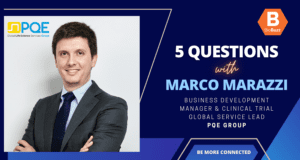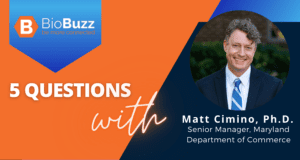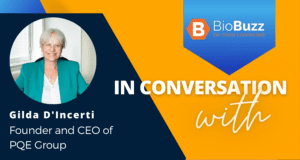
5 Questions with Eric A. Stahlberg, PhD, Director Bioinformatics and Data Science, Frederick National Laboratory for Cancer Research
“5 Questions With…” is a weekly BioBuzz series where we reach out to interesting people in the BioHealth Capital Region to share a little about themselves, their work, and maybe something completely unrelated. This week we welcome Eric A. Stahlberg, PhD, Director Bioinformatics and Data Science, Frederick National Laboratory for Cancer Research.
Dr. Eric Stahlberg is director of Biomedical Informatics and Data Science at the Frederick National Laboratory for Cancer Research (FNL). Stahlberg has been instrumental in establishing FNL’s high-performance computing initiative and in assembling scientific teams across multiple, complex organizations to advance predictive oncology.
Stahlberg joined the Frederick National Laboratory in 2011 to form and direct the National Cancer Institute’s (NCI’s) Center for Cancer Research Bioinformatics Core, which helped build intramural research collaborations between FNL and the NCI. Since then, Stahlberg has served in leadership roles in many key partnerships, including the strategic interagency collaboration between the National Cancer Institute and the Department of Energy which is focused on accelerating progress in precision oncology and computing. The collaboration is rooted in three major national initiatives: the Precision Medicine Initiative, the National Strategic Computing Initiative, and the Cancer Moonshot.
Stahlberg spearheads the Laboratory’s contributions to the NCI-DOE Collaboration programs which include the Joint Design of Advanced Computing Solutions for Cancer (JDACS4C), the ATOM consortium, and the CANDLE exascale deep learning and simulation enabled program for precision medicine in cancer. Stahlberg facilitates FNL activities to expand engagement with the broader cancer research community, including interdisciplinary projects to advance development of a cancer patient digital twin and creation of innovative approaches for radiation oncology.
He helped launch and support the annual meeting series, Frontiers in Predictive Oncology and Computing and in 2017, Stahlberg was recognized as one of FCW‘s Federal 100. Stahlberg holds a Ph.D. in computational chemistry from The Ohio State University.
1. Please introduce yourself to our audience by looking back at your education, training, and career.
As I take a quick look back at my education, training, and career, I am really humbled by the level of support I have received from so many along the way. I entered Wartburg College as a computer science major and found that I really wanted to include life science in my studies. Fortunately, my freshman chemistry professor had an interest in computational chemistry and guided me in this direction. In graduate school at The Ohio State University, I earned my PhD in theoretical chemistry and served as a post-doctoral fellow at Argonne National Laboratory. My professional opportunities included positions at Cray Research, Vital Images (a medical visualization company), Chemical Abstracts Service, the Ohio Supercomputer Center, Wittenberg University and since 2011, at Frederick National Laboratory. As I advanced in my career, I recognized the potential for computational and data science in many areas, particularly life sciences.
In 2001, at the Ohio Supercomputer Center (OSC), I made the jump to bioinformatics. My assignment was to help build a life science computing program at OSC to serve the universities across Ohio. It was a great opportunity to develop collaborations, explore new technologies in data-intensive computing applied to biological problems, support state efforts in economic development, and use HPC approaches to lean in on major life science challenges. This experience has proven invaluable to my work at FNL over the past decade.
Throughout my career I have found fulfillment in teaching and I am delighted to stay in touch with my former students. As new technologies and scientific fields have emerged, teaching early career scientists is one of my favorite challenges!
My first opportunity to teach was purely happenstance. My supervisor at Cray Research asked if I would have any interest in delivering a short course on HPC to business professionals for a local university in the Twin Cities. This opened the door for several opportunities over the years to teach and work with multiple groups of students, undergraduates to adult professionals across a range of topics.
I count myself fortunate to have diverse experience in science. I believe the lessons I learned throughout my career have made me a better teacher. As a teacher, I am gratified to support and enable the inspiring research of many scientists, develop, and extend opportunities to broaden and deepen the impact of computational and data science in cancer and disease research, and help drive innovations to accelerate insights that will improve the lives of others.
2. Please talk about the Frederick National Laboratory, and what Biomedical Informatics and Data Sciences are.
Frederick National Laboratory for Cancer Research (FNL) is a wonderful place to work on complex biomedical challenges. We are at the forefront of basic, translational and clinical science with a focus on cancer, AIDS and infectious diseases. The laboratory collaborates with the broader research community to improve human health and work in the public interest. It is a national resource and hub for large-scale efforts—and is the only national laboratory devoted exclusively to biomedical research!
As a Federally Funded Research and Development Center with 2,400 employees, FNL is sponsored by the National Cancer Institute and supports several institutes across the NIH. Most employees are in Frederick, but the laboratory supports NCI and NIH efforts across the region, across the country, and across the globe, particularly in response to emerging health threats, such as Ebola and AIDS.
The group I lead is Biomedical Informatics and Data Science – BIDS. Our group brings together advanced biomedical computational science and robust research data resources. Our cross-cutting teams deliver high-quality support and scientific insight to support the mission of the Frederick National Laboratory: enable, advance, and accelerate disease research in cancer, infectious diseases, and emerging health threats. We work collaboratively to deliver cutting-edge research insights, define frontier challenges, and advance innovations needed in the areas of informatics, computational and data science, and artificial intelligence.
We provide the advanced services, tools, and capabilities to researchers nationwide to accelerate the translation of biomedical data to scientific discoveries, insights, medical treatments, diagnostic approaches, and prevention tools for cancer, AIDS, and emerging health threats. We have developed critical genomics analytical tools for the NCI and supported research efforts for NIAID.
Our services include biomedical data management, research applications, cutting-edge technology (including high performance and scientific computing), data science, and artificial intelligence in biomedical applications.
One example is our work with NCI to deliver the Cancer Research Data Commons to the community. We support many NCI and NIAID investigators in the computational and data sciences. In all our work, we focus on fostering collaborative relationships for large-scale innovations in advanced computing to accelerate cancer research. The strategic interagency collaboration between the National Cancer Institute and the Department of Energy (DOE) enables us to bring the most advanced and powerful supercomputing technologies in the United States to drive advances in cancer research.
We also lead collaborative learning programs in deep learning, bioinformatics applications and workflow development, and new software packages.
Given the diversity of needs from across NCI, NIAID and NIH—and with external collaborators in academia, industry, and non-profit organizations—our activities in Bioinformatics and Data Science span the breadth of informatics and applications from original research to clinical trials. Our overarching goal is to improve clinical outcomes and the lives of patients.
3. You’re scheduled to be part of two upcoming events this fall including the BioHealth Capital Region Forum and its theme of Big Data….Big Bio….Converging. What does that mean to you in your role and this industry?
Fantastic question. I believe the key point to focus on is convergence. The biomedical industry is experiencing a tremendous period of growth and innovation driven by new technologies, new instruments to probe biology, and new ways to acquire, gather, and manage an immense diversity and massive volume of data. Innovations are inevitable as groups that previously haven’t connected come together, grow in understanding, and appreciate the new insights, perspectives and approaches that result from multidisciplinary team science. This is especially true in biomedicine today as the goal to promote human health, address health challenges, and generally improve quality of life are factors we can each connect with personally.
By bringing people together from different disciplines, these two events foster the broader awareness that encourages interdisciplinary collaboration across organizations and technologies. This is the best way to advance and accelerate new approaches that will accelerate impact to patients. These events are critical to gaining insight into the new technologies and approaches that are emerging and to identify potential collaborators and seed future innovations that otherwise would not be identified or attempted.
4. What do you see for the acceleration of cancer research via informatics and data science over the next 10 years?
Over the past several years, we have seen tremendous simultaneous advances in the diversity and amount of available biomedical data and in the availability and affordability of computational power. This convergence is leading to truly amazing innovations for complex biology. We view the complex phenomena more clearly as we study the inner workings of individual cells using single cell sequencing, tagging proteins in living cells, and gaining new insights into molecular interactions as cryo-EM and other advanced imaging approaches are increasingly adopted. These discoveries more effectively describe the biology and demonstrate how new AI approaches can identify features of interest to offer insights that have never been imagined for descriptive analytics in cancer research.
With the increasing capability to effectively describe cancer at new resolutions and at multiple scales, we are opening the door to an entirely new paradigm. We are moving from descriptive to predictive analytics to develop more accurate predictive models for cancer. Predictive approaches have been around for many years in cancer research, and the re-emergence of AI in the form of deep-learning are expediting a new wave of innovation and information to inform the dynamics and complexities of cancer as a disease. We are seeing the use of AI and predictive analytics to identify potential new drugs, and simultaneously to predict toxicity and efficacy and other key parameters for successful treatment.
Over the past few years, working with the NCI, we have been emphasizing the importance of predictive analytics for cancer and have seeded many projects in this area. Some of the most exciting projects that are just getting started use multiple predictive methods to explore the concept of a cancer patient digital twin or digital proxy. These efforts have started the ball rolling with a vision to develop computational predictive models for individual patients, models that are tuned to the important characteristics of the patient that impact and influence the trajectory of the disease. Given the inherent complexity of cancer this is a definite challenge. The good news is we are in a period of rapid and potential exponential advances across the research community. Already several groups have laid out plans and approaches to make progress toward the vision of a cancer patient digital twin. The goal is to help researchers explore and develop more precise treatment options and for clinicians and patients to make more informed and personalized decisions for treatment.
Over the next ten years, efforts of this type will continue to connect the research to patient impact, leading to new insights and options. The quest for new information to build cancer patient digital twins will drive new engineering for instruments that will observe biology and benefit research in ways we can only now imagine.
5. What songs would you put on the playlist of your life and why?
What an interesting question. A few songs come to mind: Journey’s ‘Don’t Stop Believing’ comes to mind simply because one must keep believing that seemingly impossible challenges can be overcome. Another song for my list is Pharrell Williams’ ‘Don’t Worry, Be Happy’ which is so uplifting and offers a wise perspective for daunting challenges. As researchers, we are in a wonderful place to work to improve the lives of others.
As surprising as it may seem, the soundtrack to Tarzan written by Phil Collins is another set of songs I would put on the list – primarily because I am a lifelong learner and really appreciate the lyric ‘In teaching you will learn, and in learning you will teach’. This is something I find very inspiring: keep sharing what I have learned, learn continuously from others, and keep opening doors for others as the path to progress.
Thank you to Eric A. Stahlberg, PhD, Director Bioinformatics and Data Science, Frederick National Laboratory for Cancer Research for participating in the “5 Questions With” BioBuzz series, and stay tuned for more interviews with others from across the BioHealth Capital Region and beyond.
- About the Author
- Latest Posts
BioBuzz is a community led, experience focused, biotech and life sciences media and events company. BioBuzz highlights regional breaking news, industry professionals, jobs, events, and resources for business and career growth. Their weekly newsletter is subscribed to by thousands in the BioHealth Capital Region and Greater Philadelphia as the go-to for industry updates.






